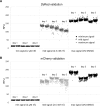A high-throughput whole cell screen to identify inhibitors of Mycobacterium tuberculosis
- PMID: 30650074
- PMCID: PMC6334966
- DOI: 10.1371/journal.pone.0205479
A high-throughput whole cell screen to identify inhibitors of Mycobacterium tuberculosis
Abstract
Tuberculosis is a disease of global importance for which novel drugs are urgently required. We developed a whole-cell phenotypic screen which can be used to identify inhibitors of Mycobacterium tuberculosis growth. We used recombinant strains of virulent M. tuberculosis which express far-red fluorescent reporters and used fluorescence to monitor growth in vitro. We optimized our high throughput assays using both 96-well and 384-well plates; both formats gave assays which met stringent reproducibility and robustness tests. We screened a compound set of 1105 chemically diverse compounds previously shown to be active against M. tuberculosis and identified primary hits which showed ≥ 90% growth inhibition. We ranked hits and identified three chemical classes of interest-the phenoxyalkylbenzamidazoles, the benzothiophene 1-1 dioxides, and the piperidinamines. These new compound classes may serve as starting points for the development of new series of inhibitors that prevent the growth of M. tuberculosis. This assay can be used for further screening, or could easily be adapted to other strains of M. tuberculosis.
Conflict of interest statement
Tanya Parish serves on the Editorial Board of PLOS ONE. This does not alter the authors' adherence to all the PLOS ONE policies on sharing data and materials.
Figures





Similar articles
-
A high-throughput screening assay based on automated microscopy for monitoring antibiotic susceptibility of Mycobacterium tuberculosis phenotypes.BMC Microbiol. 2021 Jun 5;21(1):167. doi: 10.1186/s12866-021-02212-3. BMC Microbiol. 2021. PMID: 34090328 Free PMC article.
-
A dual read-out assay to evaluate the potency of compounds active against Mycobacterium tuberculosis.PLoS One. 2013 Apr 4;8(4):e60531. doi: 10.1371/journal.pone.0060531. Print 2013. PLoS One. 2013. PMID: 23593234 Free PMC article.
-
High throughput screen identifies small molecule inhibitors specific for Mycobacterium tuberculosis phosphoserine phosphatase.J Biol Chem. 2014 Sep 5;289(36):25149-65. doi: 10.1074/jbc.M114.597682. Epub 2014 Jul 18. J Biol Chem. 2014. PMID: 25037224 Free PMC article.
-
Target Discovery for New Antitubercular Drugs Using a Large Dataset of Growth Inhibitors from PubChem.Infect Disord Drug Targets. 2020;20(3):352-366. doi: 10.2174/1871526519666181205163810. Infect Disord Drug Targets. 2020. PMID: 30520384 Review.
-
Perspective: Challenges and opportunities in TB drug discovery from phenotypic screening.Bioorg Med Chem. 2015 Aug 15;23(16):5087-97. doi: 10.1016/j.bmc.2014.12.031. Epub 2014 Dec 24. Bioorg Med Chem. 2015. PMID: 25577708 Review.
Cited by
-
Multiple Mutations in Mycobacterium tuberculosis MmpL3 Increase Resistance to MmpL3 Inhibitors.mSphere. 2020 Oct 14;5(5):e00985-20. doi: 10.1128/mSphere.00985-20. mSphere. 2020. PMID: 33055263 Free PMC article.
-
Novel chemical entities inhibiting Mycobacterium tuberculosis growth identified by phenotypic high-throughput screening.Sci Rep. 2022 Sep 1;12(1):14879. doi: 10.1038/s41598-022-19192-7. Sci Rep. 2022. PMID: 36050506 Free PMC article.
-
Mycobacterial drug discovery.RSC Med Chem. 2020 Nov 6;11(12):1354-1365. doi: 10.1039/d0md00261e. RSC Med Chem. 2020. PMID: 34085044 Free PMC article. Review.
-
Synthesis and Characterization of Phenylalanine Amides Active against Mycobacterium abscessus and Other Mycobacteria.J Med Chem. 2023 Apr 13;66(7):5079-5098. doi: 10.1021/acs.jmedchem.3c00009. Epub 2023 Mar 31. J Med Chem. 2023. PMID: 37001025 Free PMC article.
-
Deep learning-driven bacterial cytological profiling to determine antimicrobial mechanisms in Mycobacterium tuberculosis.Proc Natl Acad Sci U S A. 2025 Feb 11;122(6):e2419813122. doi: 10.1073/pnas.2419813122. Epub 2025 Feb 6. Proc Natl Acad Sci U S A. 2025. PMID: 39913203 Free PMC article.
References
-
- World Health Organization. Global tuberculosis report 2017.
-
- Galandrin S, Guillet V, Rane RS, Leger M, N R, Eynard N, et al. Assay development for identifying inhibitors of the mycobacterial FadD32 activity. J Biomolec Screen. 2013;18(5):576–87. - PubMed
-
- Humnabadkar V, Jha RK, Ghatnekar N, De Sousa SM. A high-throughput screening assay for simultaneous selection of inhibitors of Mycobacterium tuberculosis 1-deoxy-D-xylulose-5-phosphate synthase (Dxs) or 1-deoxy-D-xylulose 5-phosphate reductoisomerase (Dxr). J Biomolec Screen. 2011;16(3):303–12. - PubMed
-
- Kumar A, Casey A, Odingo J, Kesicki EA, Abrahams G, Vieth M, et al. A high-throughput screen against pantothenate synthetase (PanC) identifies 3-biphenyl-4-cyanopyrrole-2-carboxylic acids as a new class of inhibitor with activity against Mycobacterium tuberculosis. PLOS One. 2013;8(11):e72786 10.1371/journal.pone.0072786 - DOI - PMC - PubMed
Publication types
MeSH terms
Substances
LinkOut - more resources
Full Text Sources
Molecular Biology Databases
Miscellaneous

